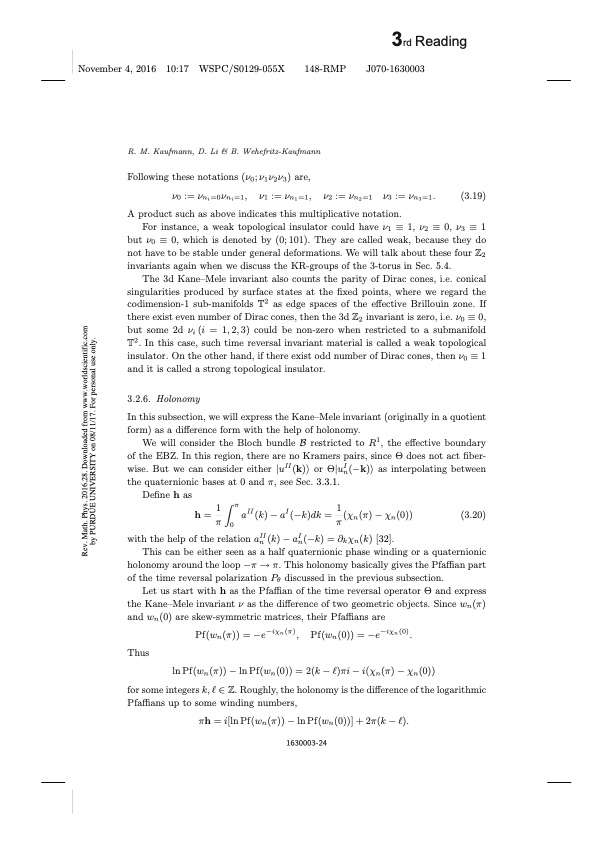
PDF Publication Title:
Text from PDF Page: 024
R. M. Kaufmann, D. Li & B. Wehefritz-Kaufmann Following these notations (ν0; ν1ν2ν3) are, ν0 := νni=0νni=1, ν1 := νn1=1, ν2 := νn2=1 ν3 := νn3=1. (3.19) A product such as above indicates this multiplicative notation. For instance, a weak topological insulator could have ν1 ≡ 1, ν2 ≡ 0, ν3 ≡ 1 but ν0 ≡ 0, which is denoted by (0; 101). They are called weak, because they do not have to be stable under general deformations. We will talk about these four Z2 invariants again when we discuss the KR-groups of the 3-torus in Sec. 5.4. The 3d Kane–Mele invariant also counts the parity of Dirac cones, i.e. conical singularities produced by surface states at the fixed points, where we regard the codimension-1 sub-manifolds T2 as edge spaces of the effective Brillouin zone. If there exist even number of Dirac cones, then the 3d Z2 invariant is zero, i.e. ν0 ≡ 0, but some 2d νi (i = 1, 2, 3) could be non-zero when restricted to a submanifold T2. In this case, such time reversal invariant material is called a weak topological insulator. On the other hand, if there exist odd number of Dirac cones, then ν0 ≡ 1 and it is called a strong topological insulator. 3.2.6. Holonomy In this subsection, we will express the Kane–Mele invariant (originally in a quotient form) as a difference form with the help of holonomy. We will consider the Bloch bundle B restricted to R1, the effective boundary of the EBZ. In this region, there are no Kramers pairs, since Θ does not act fiber- wise. But we can consider either |uII (k)⟩ or Θ|uIn(−k)⟩ as interpolating between the quaternionic bases at 0 and π, see Sec. 3.3.1. (3.20) Define h as π h = 1 aII (k) − aI (−k)dk = 1 (χn(π) − χn(0)) π0π with the help of the relation aII (k) − aI (−k) = ∂ χ (k) [32]. nnkn This can be either seen as a half quaternionic phase winding or a quaternionic holonomy around the loop −π → π. This holonomy basically gives the Pfaffian part of the time reversal polarization Pθ discussed in the previous subsection. Let us start with h as the Pfaffian of the time reversal operator Θ and express the Kane–Mele invariant ν as the difference of two geometric objects. Since wn(π) and wn(0) are skew-symmetric matrices, their Pfaffians are Thus Pf(wn(π)) = −e−iχn(π), Pf(wn(0)) = −e−iχn(0). ln Pf(wn(π)) − ln Pf(wn(0)) = 2(k − l)πi − i(χn(π) − χn(0)) for some integers k, l ∈ Z. Roughly, the holonomy is the difference of the logarithmic Pfaffians up to some winding numbers, πh = i[ln Pf(wn(π)) − ln Pf(wn(0))] + 2π(k − l). 1630003-24 Rev. Math. Phys. 2016.28. Downloaded from www.worldscientific.com by PURDUE UNIVERSITY on 08/11/17. For personal use only.PDF Image | Notes on topological insulators

PDF Search Title:
Notes on topological insulatorsOriginal File Name Searched:
RMP.pdfDIY PDF Search: Google It | Yahoo | Bing
Sulfur Deposition on Carbon Nanofibers using Supercritical CO2 Sulfur Deposition on Carbon Nanofibers using Supercritical CO2. Gamma sulfur also known as mother of pearl sulfur and nacreous sulfur... More Info
CO2 Organic Rankine Cycle Experimenter Platform The supercritical CO2 phase change system is both a heat pump and organic rankine cycle which can be used for those purposes and as a supercritical extractor for advanced subcritical and supercritical extraction technology. Uses include producing nanoparticles, precious metal CO2 extraction, lithium battery recycling, and other applications... More Info
| CONTACT TEL: 608-238-6001 Email: greg@infinityturbine.com | RSS | AMP |